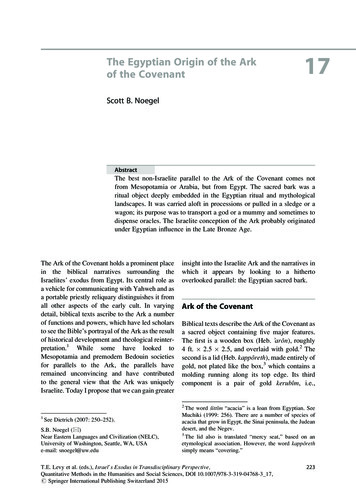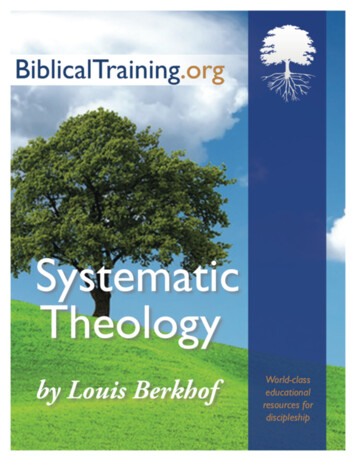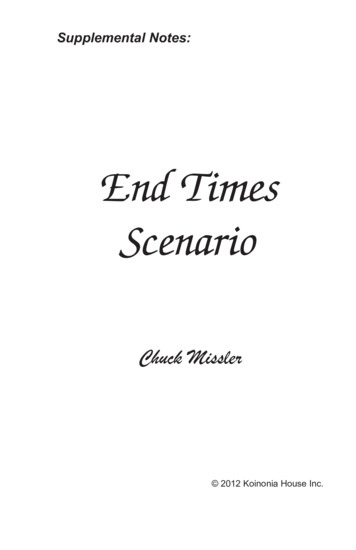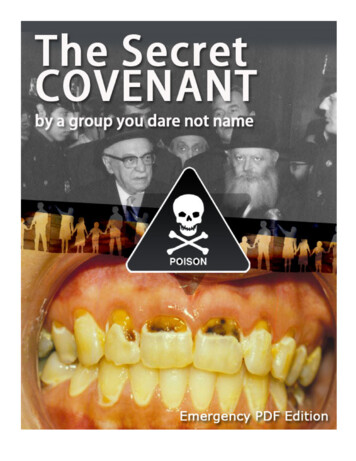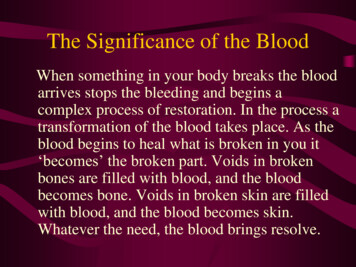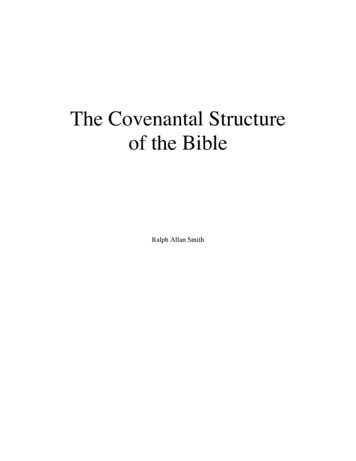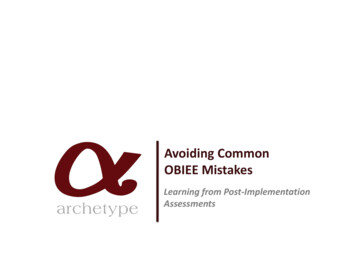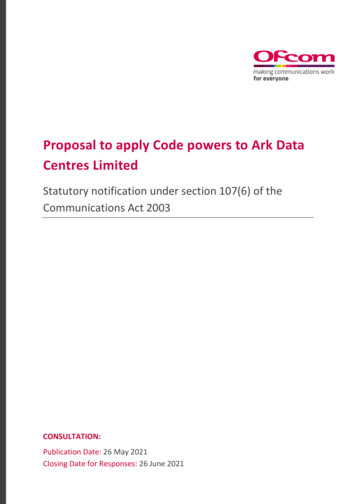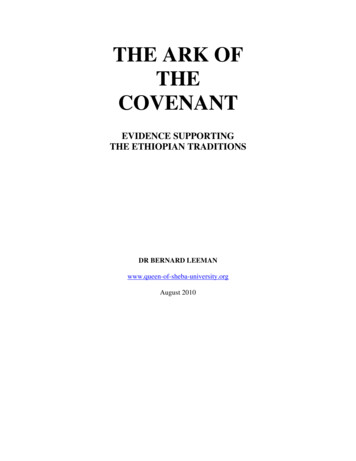
Transcription
THE ARK OFTHECOVENANTEVIDENCE SUPPORTINGTHE ETHIOPIAN TRADITIONSDR BERNARD LEEMANwww.queen-of-sheba-university.orgAugust 2010
CONTENTSThe Ark of the CovenantPage1Appendix A1. The Jewish Torah2. The Israelite Torah According to the Sheba-Menelik CycleAppendix BComparison of events during the Queen of Sheba’s visit to King SolomonAppendix CGe’ez transcript of sections of the Sheba-Menelik Cycle of the KebraNagast concerning the route of the Ark of the Covenant from Jerusalem toEthiopiaGe’ez text of Chapter 53 of the Kebra NagastGe’ez text of Chapter 55 of the Kebra NagastGe’ez text of Chapter 58of the Kebra NagastGe’ez text of Chapter 59 of the Kebra NagastTransliterated and translated Chapter 53 [first section]Transliterated and translated Chapter 55 [extracts]Transliterated and translated Chapter 58 [sentence four onwards]Transliterated and translated Chapter 59 [first SMap 1: The geography of Menelik’s route according to the Kebra Nagastwith Jerusalem in Palestine and Msr/Msrm translated to mean EgyptMap 2: The geography of the movements of the Ark of the Covenantaccording to the Salibi hypothesisPhoto of the oldest known inscription mentioning the Hebrew peopleMap 3: True location of the Old Testament pre-586 B.C.?Picture of Xi Wang Mu, the Chinese Queen of Sheba?131518191112383940
THE ARK OF THE COVENANTUntil the twentieth century it was generally accepted that the events described inthe Biblical Old Testament before the Babylonian captivity (ca.586 B.C.) occurred inthe area of modern Israel, Palestine, Egypt, and Iraq (Babylon). Abraham wassupposed to have come from Ur in Mesopotamia, the Hebrews held captive in Egypt,the Exodus to have taken place in the Sinai peninsular and Joshua’s invasion launchedacross the River Jordan. When professional archaeologists commenced digging in theHoly Land in 1920 they fully expected to uncover evidence of the Exodus, thedestruction of Canaanite cities, the establishment of Israelite kingdoms, large publicworks undertaken by King Solomon and King Omri, the 722-1 B.C. Assyriandestruction of Israel, and the 587-586 B.C. Babylonian conquest of Judah and thedestruction of Jerusalem. However doubts emerged among archaeologists in the1960’s [Kenyon] that escalated in the 1970’s [Pritchard] and finally developed in the1990’s and at the turn of the twenty-first century into outright dismissal of the pre-586B.C. Biblical account [Finkelstein, Herzog, Lemche, Sand, Silberman, Thompson,Van Seter, Whitelam]. Today leading so called “minimalist” Israeli, American,British, and Danish-based archaeologists believe that Moses, Joshua, David andSolomon never existed and the pre-Babylonian captivity narrative was either fantasyor highly exaggerated. Their opinions are opposed by “maximalist” often faith-basedscholars and archaeologists [Bright, Dever, A. Mazar, B. Mazar]. The issue is verycontroversial because many observers interpret the minimalist hypothesis asundermining the raison d’être of the State of Israel.In the nineteenth century a number of writers and academics [Dozy et al 1]suggested that Arabia, not Palestine, may have been the true location of the pre-586B.C. events described in the Old Testament. Other researchers added to thishypothesis in the first half of the twentieth century, postulating that the rise of Islammay have been deeply influenced by close contact with a long established local Judaiccommunity [Margoliouth, Montgomery, Torrey]. In 1985 the debate becameextremely heated following the publication of Professor Kamal Salibi’s book TheBible came from Arabia. Salibi based his findings on Arab traditions and place namesin Asir, Hijaz and Jizan provinces of present Saudi Arabia and concluded that AncientIsrael and Judah prior to 586 B.C. were in West Arabia spanning territory from northof Medina to Yemen. While incensing the maximalists, Salibi’s work was alsocondemned by Saudi Arabia, which believed he was suggesting that Israel had adivine right to annex its western provinces of Hijaz, Asir and Jizan. InterestinglySalibi received no support from the minimalists, one of whom (Silberman) privatelyimplied to this writer that it was safer to deny the historical record than suggest it wastrue but located in West Arabia.1C. T. Beke, T. K Cheyne, Reinhart Pieter Dozy, Heinrich Graetz, F. Hommel, W. V. Kelly, H. Ooort,A. H. Sayce, N. Schmidt, J. Taylor, J. Wilson, and H. Winckler
2The solution to the divide in Old Testament archaeology appears to rest inancient Ethiopian traditions, inscriptions and documents concerning the Ark of theCovenant, the most revered possession of the Hebrew people. The Beta Israel (“BlackJews of Ethiopia”) and the Ethiopian Orthodox Church believe the Ark was brought toEthiopia in about 950 B.C. by Menelik, son of King Solomon and the Queen of Sheba.This booklet argues that the story is true.The Hebrew Old Testament is silent on the fate of the Ark of the Covenant butthe second century B.C. Second Book of Maccabees states it was hidden at Mt Neboduring the Babylonian invasion and destruction of 587-586 B.C. Traditions fromArabia, where arks were still being carried into battle in the 1920’s A.D. [Grierson andMunro-Hay:176-194, 244a] say the Arabs captured it from the Israelites in battle andit was flung on a dunghill [Parfitt 2008:213]The most detailed account of what happened to the Ark is contained in the Ge’ez(Ancient Ethiopic) epic Kebra Nagast (Glory of the Kings). The Kebra Nagast wascomplied in about A.D. 1314 in Aksum. It consists of two intertwined maindocuments of roughly equal length and a short conclusion. The earliest part is a totallyIsraelite (i.e. pre- 586 B.C.) document known as the Sheba-Menelik Cycle and appearsto have been originally recorded in Solomon’s reign. The second part, the CalebCycle, was probably written in about A.D. 520 on the eve of the Christian invasion ofJewish Yemen [Shahid 1976; Leeman 2005, 2009]. A thorough study of the literarysources of the Kebra Nagast was undertaken in a 1956 doctoral thesis at St Andrew’sUniversity Scotland by the late David Hubbard, who became principal of FullerTheological College in California. Hubbard agreed with many earlier researchers thatthe Sheba-Menelik Cycle had been translated into Ge’ez from Arabic not from Copticas the compilers claimed.The Cycle begins with the account of the visit of the Queen of Sheba toSolomon’s capital of Jerusalem. The queen stays several months and just before sheleaves Solomon insidiously tricks her into bearing his child, knowing that this willcause her to lose the right to rule in Yemen. The queen gives birth to her son Menelikon the bank of the Mai Bela stream in what is now Eritrea (“her mother’s country”)and remains queen of her African possessions with a capital at Aksum.When Menelik comes of age he insists his mother names his father as he is tiredof his friends’ taunting. Eventually he receives the queen’s approval to visit Solomon.Solomon is delighted with Menelik and when Menelik declines his offer to stay inJerusalem Solomon makes arrangements for the establishment of a client Israelite statein Ethiopia administered by the eldest sons of the hierarchy of Solomon’s kingdom.The eldest sons of the ruling elite led by Azariah, son of Zadok the high priest,are not happy with this arrangement and take steps to steal the Ark of the Covenant tosustain them in their new land. Azariah drugs the celebrants at the farewell dinner andenters the temple through a secret door removing the Ark from under its silk coveringand replacing it with a wooden structure.
3Menelik is oblivious to the theft and it is only after his party has travelled someway from Jerusalem that Azariah reveals the Ark. Menelik is shocked but then assentsto the theft. The party races for Ethiopia.Meanwhile Solomon is reminiscing with Zadok but his account of a dream inwhich he saw the Sun move from Judah to Ethiopia alerts Zadok, who rushes to theTemple and finds the Ark gone. Solomon orders an immediate pursuit but by the timehis troops reach the coast, Menelik “has crossed to Ethiopia opposite Mt Sinai” (sic).The Queen of Sheba agrees to rule jointly with Menelik. Dual monarchies inAksum were still common in the Christian era. At length the queen abdicates andallows Menelik to rule alone over a mixed population of Sabaeans, Ethiopians andIsraelites. The religion is officially Israelite, centred on the Ark of the Covenant(tabot) and the Law of Moses (orit). The state is regarded as the new Zion. TheSheba-Menelik Cycle states that Menelik expanded his territory.Traditions from Tanzania and the Comoros islands respectively state thatMenelik died and was buried in the crater of Mt. Kilimanjaro2 [Tanganyika Times 10February 1928] and that Edomites stole the throne of Solomon and placed it in thecrater of Mt. Katala [Prosperi 1957:142-3].The Sheba-Menelik Cycle only describes events before 925 B.C. so it mentionsneither Solomon’s death nor the breakup of his kingdom. The Old Testament Book ofKings and Josephus’s History of the Jews have accounts of the Queen of Sheba’s visitto King Solomon both of which appear to be summaries of the Sheba-Meneliknarrative except they say nothing of events after the queen’s departure, such as thebirth of Menelik, his visit to Jerusalem and the theft of the Ark. The Islamic Qur’anaccount differs in that it tells the story from Solomon’s perspective [see Appendix B].The EvidenceThe most important inscriptional evidence supporting the Sheba-Menelik Cycleis found on two of three Sabaean incense burners [photo, page 37] kept in the Churchof Abun Garima at Adi Kaweh, a hilltop village eight kilometers south-west ofWukro, near Mekele in Ethiopia [Schneider 1973; Leeman 2009]. The church is sitedon a much older structure, most probably a major Sabaean temple, because the twolarger incense burners were found a short distance respectively at and below two otherhill top Sabaean structures to the east and west of Adi Kaweh. The eastern site is thealleged burial place of Queen Yodit, the pagan-Hebraic leader who destroyed Aksumin the 10th century A.D., and also the location of ca.800 B.C. Sabaean temple in theprocess of excavation [Leeman 2009]. The Sabaean inscriptions state that the area waspart of the realm of D’mt and was ruled by four named high kings and kings of Sheba2Kilimanjaro’s crater was known to the Ethiopians before it was rediscovered by the Ashira Marangu armyscout Kinyala Johannes Lauwo (1871-1996 [sic]) in the 1880’s and “officially” by Hans Meyer and LudwigPurtscheller in 1889. Lauwo climbed the peak nine times before he realised there was a crater. He served asguide for the Meyer and Purtscheller’s 1889 first successful European ascent. Johannes Notch is namedafter him. www.ntz.info/gen/n00398.html. Leeman video interview with Kinyala Lauwo, Ashira 1993
4and D’mt, three of whom ruled with unnamed high queens and queens of Sheba3 overa mixed population of red (Semitic) Sabaeans and black (Cushitic)’BR (Hebrew)[Schneider 1973, Fattovich 1990].4 The inscriptions are the work of professional stonemasons from Marib (Yemen) and indicate that the Sabaeans were at that time makinga major effort to dominate the area while cooperating in conjunction with the local(probably Cushitic) population [Durrani:122] It is generally assumed that the realm ofD’mt with a major centre at Yeha, the site of a huge Sabaean temple, gave way toAksum around the first century B.C. but this is not absolutely certain and the D’mtrealm may have lasted until Queen Yodit’s time (she was queen of “Damot” ca. A.D.970). The Adi Kaweh inscriptions therefore support the story that a mixed populationof Sabaeans and Hebrew (Israelites) was ruled jointly by kings and queens of Sheba innorthern Ethiopia one hundred and twenty five years after Solomon’s death andprobably much earlier. The inscriptions at Adi Kaweh are the oldest mention of theHebrew people.The next piece of information concerns ancient Hebrew-Israelite populations,traditions, religious practices and customs in Ethiopia, Somalia and Eritrea. Until mostwere evacuated to Israel in the late 1980’s Ethiopia possessed a large population ofBeta Israel (“Black Jews”, “Falasha”). They are the only “Judaic” group to containNazarites (like Samson). In addition there are many Ethiopians who claim they areIsraelite in origin but converted to Christianity. These are known as “Falasha Mura.”Next are the Qemant, who practise a religion described as “pagan-Hebraic” [Gamst];and the Yibir/Ibro (“Hebrew”), a landless Agaw serf caste in Somaliland, who arenominally Muslim but traditionally are despised and partly feared as being paganHebraic sorcerers [Kirk 1905:184, Farah 2006:6, Leeman 2005, 2009]. In additionthere is a group in Eritrea associated with the traditional landowning aristocracy ofHamasien and the present leadership of the Eritrean government known as “Latos” or“Mai Bela.” Because they are so secretive, no more than a paragraph has beenpublished about them. The Israelis recognise them as Jews but they seem to a mixtureof Israelites and Christians, a sort of Judeo-Christian group with a headquarters atHimberti, priests called kes and holy places called kansha [from kanisa meaning achurch]. Outsiders call them Latos, from Pilatos (Pontius Pilate Christ killer). Theycall themselves Mai Bela, from the river bank where Menelik was born [Leeman2005, 2009].Besides the pagan-Hebraic and Israelite groups there are the Ethiopian OrthodoxChristians themselves who retain ancient Judaic practices and other elements, some ofwhich are no longer associated with “main stream” Judaism. The chief authority onHebraic influences in Ethiopia is Professor Edward Ullendorff [1920 - ], who3Despite continuing protests Wikipedia refuses to alter its erroneous statement in its D’MT entry that awork by Nadia Durrani [2005] names the queens4Neither of these “maximalist” authorities translated ’BR (Hebrew) although the discovery of the word nearor in modern Israel would have caused enormous interest. See excitement over similar words:http://en.wikipedia.org/wiki/Habiru
5supervised David Hubbard’s thesis on the Kebra Nagast but unfortunately publishedhis own work with untranslated important quotations from many dead and livinglanguages (e.g. Syriac, Ge’ez, Latin, Greek, Hebrew, Portuguese). Despite this,Ullendorff [1956, 1968] concludes that the Hebraic and First Temple Israeliteinfluences in Ethiopia are very ancient while the Lebanese historian Kamal Salibi[1998b:62-63] suggests that a form of Israelite religion (“Nazarene”) associated withexiles who fled to Yemen from the destruction of the First Temple in Jerusalem wasinfluential at the court of Aksum from about 586 BC to A.D. 332 and this faith wasincorporated into Christianity in the fourth century A.D. to accommodate the traditionthat Aksum was the True Zion as well as the keeper of the True Faith (MonophysiteChristianity). Others argue that Monophysite Christianity around Antioch, Alexandria,and Byzantium/Constantinople had itself incorporated Jewish practices from the“Greeks” (Hellenised Jews) who formed the nucleus of early Christianity. Whateverthe reason Ethiopian Christianity has a significant element of First Temple Israelitereligion within it and some clerics such as Ewostatewos (ca.1273-1352) at DebraBizen in Eritrea went into exile rather than accept a ban on “Jewish” practices, whichis why both Saturday and Sunday are still respected as holy days [Tamrat 1977, Beylot1995]. Ullendorff believes that maybe half of Ethiopia’s population was Israelite whenChristianity was introduced. In areas such as Agame (where people still endure theinsult “Yehud”) in northern Ethiopia and in Hamasien in Eritrea mass acceptance ofChristianity has allegedly been fairly recent but the Latos/Mai Bela have chosenwestern churches instead of the Orthodox [Leeman 2005:185-6] and totally ignoreAsmara’s Italian synagogue.Fourth is the Ge’ez word for the Ark of the Covenant – “tabot.” There are twomain authorities on this word. The first, Theodore Nöldeke (1836-1930) was soconfused by the word that he termed it an “atrocious monstrosity” [Nöldeke 1860:211]because in his view the word should not exist because it had somehow come toEthiopia during Solomon’s time. The second scholar, Chaim Rabin (1915-1996), wasalso deeply perplexed by the word. He concluded that the word was indeed ancientand had come from the Medina area of Arabia during Solomon’s era [Rabin1951:109].Fifth, the Hebrew Old Testament and Jewish traditions do not record how theArk of the Covenant vanished. Nor do they explain why Azariah the high priest ofJudah (the Sheba-Menelik Cycle identifies him as the son of the high priest)disappeared and his Zadokite priesthood only reappeared three hundred years later[Benjamin Mazar: 1992:98]. The Sheba-Menelik Cycle is the only document thatdetails the reasons.Sixth, the Sheba-Menelik Cycle contains the Torah/Orit (Law of Moses) thatmust have existed during the time of King Solomon [Leeman 2005, 2009]. It iscertainly much older than the Torah in the “official” Old Testament because it omitsthe major part of the Laws of Deuteronomy, the Biblical book that authorities agreewas compiled in the reign of Josiah (ca. 640-609 B.C.) during the high priesthood of
6Hilkiah [Wright, 1996:6]. Hubbard noted that the Sheba-Menelik Cycle containsvariants of the Old Testament whereas the Old Testament quotations in the CalebCycle adhere to the Christian era “official” Ge’ez version of the Old Testament. TheSheba-Menelik Cycle contains the Holiness Code [Leviticus 17-26], which BiblicalScholars agree is one of the oldest parts of the Old Testament.Next, the German missionary Johann Martin Flad [1831-1915], noted that theBeta Israel, the First Temple Israelite Cushitic population of Ethiopia who have nowmostly adopted Semitic Tigrinya and Amharic, recited Hebrew prayers in Agaw,although most no longer understood the meaning [Flad 1869; Leslau 1951:xxi].In summarising the above evidence it seems that at the very least Ethiopia has anancient association with the Israelite First Temple and a culture obsessed even todaywith the Ark of the Covenant reflecting the ancient existence of an Israelite state thateventually nearly obliterated the Christian state of Aksum under its pagan-HebraicQueen Yodit ca. A.D. 970. It appears impossible to accept relatively recent writers’contentions [Hancock, Kaplan, Quiran, Shelemay] that the Beta Israel adopted asyncretic form of Judaism from ca 500-400 B.C. Aramaic speaking Israelite troops atElephantine (Aswan in Egypt) on the Nile or affected it in medieval times to distancethemselves from their Semitic-speaking Christian overlords and escape imperialtaxation.There is much more. Ironically it is the seemingly ludicrous geographicalreferences in the Sheba-Menelik Cycle that convincingly demonstrate that the Ark wasindeed stolen from Jerusalem and brought to Ethiopia three thousand years ago andthis leads to far greater issue of immense implications that most Biblical scholars willnot even mention.Ethiopia is right, Israel is wrongMillions of dollars fund Old Testament research in the Holy Land (Palestine andModern Israel). Although the Beta Israel are Africa’s most studied people, Ethiopianstudies receive very little funding. Even the Wukro I site at Adi Kaweh, which mayprove to be one of Biblical archaeology’s most important sites, is being excavated by a“maximalist” German team. William Dever, who ridiculed Salibi, has received over amillion dollars of archaeological funding but has never once made any investigation ofthe origins of Arabian Judaism [Leeman 2005:149] which, as Torrey observed, isseemingly illogical because most Arabian Jews were historically located in the Yemenand their numbers diminished towards Palestine, whereas it would be more reasonableto expect the opposite should be true [Torrey1967:21].Although Old Testament scholars ignored or vilified Salibi, his hypothesis, asMazrui noted, appears to support the Sheba-Menelik Cycle’s narrative as well assolving issues concerning Arabian Judaism. In his 1951 publication Ancient WestArabian, Chaim Rabin noted that there was a large amount of Hebrew vocabulary andgrammar in the dialects of West Arabia. He could offer no explanation for the“surprising similarities and parallelisms of West Arabian with Canaanite” [Rabin:2-
73]5 and concluded, “This is not the place to work out the historical implications ofthis, especially as it affects the darkest part of Arab history” [Rabin:199].Fascinatingly, these dialects were in exactly the same area that Salibi had found theplace names of the Hebrew Old Testament although he himself only realised it in 2010[email to Leeman 2 March]. Secondly there are very obvious reasons why an ancientArabian Judah could have prospered and reached a zenith in the period 1000-925 B.C.and then lost power to Israel in Omri’s reign. Salibi placed Israel in the northern Hijaznear Medina and Judah in the south in Asir next to Yemen. Following the ca. 1200B.C. domestication of the camel, which Arab traditions ascribe to the Hebrew, thewestern Arabian escarpment became an important trade route for Sabaean/Shebangold, gemstones and incense caravans and attracted Egyptian and Assyrian imperialcontrol. However, between about 1000-925 B.C. the Egyptians withdrew to deal withinvasions by the Sea Peoples [Kitchen 2003: 99-100] while Assyria pulled back tocounter the threat of Aramaean population movements near the border of what is nowmodern Turkey [Lipiński 2000]. These withdrawals opened the way for anopportunistic local population (e.g. the Hebrew) to seize control of the lucrativeSabaean trade and grow rich from taxing the caravans. Despite the 460 year captivityHebrew has no Egyptian words but Rabin noted in another work that it contains tradewords such as “sapphires” from India, which appears to indicate it was on a majortrade route from India to Egypt [Rabin 1968].Salibi’s work has been of vital assistance in deciphering the geography of theSheba-Menelik Cycle and had he taken much earlier notice of the large number ofemails and letters urging him to consider Rabin’s work and the Ethiopian evidence hisarguments, too reliant on place names, would have probably gained much wideracceptance.Much confusion has been caused in Old Testament studies because of placenames. Edward Robinson was chiefly responsible for the haphazard unscientificwildly speculative methods used to identify locations in Palestine in 1837-8 and 1852[Leeman 2005:22]. European Jewish traditions and scholarship have also been veryunreliable, being over-influenced by the drive to prove that Palestine is the PromisedLand and therefore the Jewish homeland through divine will. The definitive HebrewOld Testament was published in about A.D. 950, six hundred years after the NewTestament, by the Masoretic scholars, two priestly families based in Galilee andBabylon. These scribes laboured for four hundred and fifty years to complete theirtask. The original Old Testament had been written only with Hebrew consonants sincevowels were considered divine sounds. Languages change over time, sometimesrapidly. For example modern English speakers would find it impossible to understandthe English of King Harold of Hastings let alone the Anglo-Saxon of A.D.500.The Arabic and Aramaic speaking Masoretic scholars put the vowels into the HebrewOld Testament while admitting that in three hundred and fifty places they had no idea5The Hebrew adopted Canaanite as their language.
8of the original meaning [Encyclopaedia Judaica]. Words such as MSR and MSRMwere taken to mean Egypt, while KWS and KSM were equated with Ethiopia orSudan. Salibi suggested that in some places these words refer to cities not countries.He also argued that the Jordan (H-YRDN) was not a river but the escarpment inArabia that rises from the coastal plain to the mountain range known as the Tihama orSarawat. Many Arab traditions support Salibi’s suggestions. For example Mecca isassociated with Abraham and there is an ancient tradition the Red Sea was onceblocked by a volcanic lava flow at the strait of Bab-el-Mandeb between Yemen andEritrea which then broke causing massive death and destruction in the subsequentflood. Interestingly the word for Hebrew in Hebrew and Sabaean is not only identical(’BR) but has a second meaning in both languages of “those who crossed over”[Biella:350]. Since the Beta Israel and the Zagwe royal house have strong traditionsabout Moses, there is speculation that Moses’ Red Sea crossing may have been at itssouthern end. Support for this comes from Moses’ marriage to Zipporah, the Cushitedaughter of the Prophet Jethro. Salibi places Zipporah’s home as Kush (Kshm) next tothe volcanic mountain in northern Yemen named Jebel al-Nabi Shu’ayb - themountain of the prophet Shu’ayb. Shu’ayb is Arabic for Jethro. In 1997 a team ofCanadian archaeologists [Keall 1997] discovered a ring of large monoliths on thecoastal plain below Jebel al-Nabi Shu’ayb dating from about 1800 B.C. (Moses’ era)and therefore, if Salibi’s Arabian location for the Exodus is true, the pillars may be thesame mentioned in Exodus 24:4. Perhaps the Hebrew captivity occurred near or inEthiopia.Whoever wrote the Sheba-Menelik Cycle was obviously not referring to aJerusalem in Palestine. On page 11 is a map of Menelik’s journey from Jerusalem toEthiopia with Jerusalem sited in Palestine. The account makes no sense.When Salibi’s book was published in 1985 this writer wrote to him about thestrange geography of the Sheba-Menelik Cycle and asked him to send his hypotheticalmap of an Arabian Judah marking place names mentioned in the Ethiopian documentin case the Cycle’s contents matched his hypothesis of an ancient Judah in WestArabia. Salibi replied [Letter 15 February 1987] that he was not conversant with theSheba-Menelik Cycle but kindly sent his map. The result was sensational for itshowed that the author of the Sheba-Menelik Cycle was referring to a Judah oppositeEthiopia in West Arabia not to one in Palestine.A map of Menelik’s journey from Jerusalem to Ethiopia with Jerusalem andother locations sited by Salibi in West Arabia is on page 12. Since Salibi drew his mapblind to the Sheba-Menelik Cycle narrative of the journey of the Ark from Jerusalemto Ethiopia, the result is quite astonishing. It explains why the Beta Israel traditionallyprayed to a Jerusalem in the east (in Arabia), not one to the north (in Palestine). Itwould also explain why the word “Falasha” and the word for the Beta Israel’s houseof prayer are both Sabaean in origin [Biella;405; Leslau 1991:363] but most of all whyEthiopian culture is so heavily Judaic, obsessed with the Ark and drew its politicallegitimacy from Moses (Zagwe dynasty ca A.D. 1137-1270) and Solomon (Haile
9Selaisse). The short period of imperial Sabaean occupation and high culture ca.800 –500 B.C. could probably be attributed to Sabaean attempts to find other trade routes toescape the instability in West Arabia as the united kingdoms of Israel and Judah viedfor supremacy and were then respectively destroyed by Assyria and Babylon.Jacqueline Pirenne [1918-1990] suggested that the Beta Israel, First Temple Israelites,were refugees from the Assyrian (772 B.C.) and Babylonian (587 B.C.) conquests[Munro-Hay 1991:65]. Two Sabaean monarchs gave tribute to the Assyrians in 456and 487 B.C., indicating the Assyrians were far closer than Palestine. [Schippmann2001:39].Although the Ethiopian evidence supporting the Salibi hypothesis has been widelydistributed since 1985 it has been completely ignored in almost every publication. TheSaudi reaction was extreme, bulldozing sites named by Salibi as probable locations ofOld Testament cities such as An Nimas (Jerusalem), south of Taif. Salibi’s book wasbanned in Saudi Arabia and Syria for implying that Modern Israel should annex Asirand Hijaz provinces. All references to this writer’s work that argued that evidencefrom the life of the Queen of Sheba supports Salibi’s hypothesis have systematicallybeen removed from Wikipedia from early 2010 onwards and a Saudi student arrestedand briefly jailed when a copy was found on his return home. While the EthiopianOrthodox Church, the Beta Israel, the Yemeni Jews, the Rastafarians, Ethiopian andEritrean university students and tour guides, and David Hubbard were intrigued by theidea of an Arabian Judah, it was not considered of any merit by Israel Finkelstein,Roderick Grierson, Graham Hancock, Stuart Munro Hay, Richard Pankhurst, RogerSchneider, Kay Kaufmann Shelemay, Thomas Thompson, and two thousand (sic)other Biblical and Ethiopian scholars and writers contacted between 1990 and 2010.If Ancient Israel and Judah were indeed located in West Arabia it would make theresearch of thousands of academics appear extremely careless and trivial andcompletely undermine the raison d’être of the State of Israel. One importantconsequence however would be to make early Ethiopian history, Beta Israel andEthiopian Orthodox Church traditions, and the Ge’ez language major biblical andhistorical academic disciplines. However the Arabian Judah hypothesis appears toomuch of a threat to academic funding, academic reputations, Holy Land tourism, andpolitical agenda to warrant consideration let alone open debate.ConclusionThe Ark of the Covenant, according to the few reliable accounts that exist, is awooden box containing a milky stone tablet that in the past exuded a mysterious light.It is almost certainly housed in Aksum and came to Ethiopia during Solomon’s reignfrom Arabia. Most people who have written about the Ark never carefully read theSheba-Menelik Cycle in Ge’ez. The best translation is by Carl Bezold in German in1909 (republished 2009). A very inferior version was accomplished by Ernest WallisBudge, who appears merely to have translated Bezold’s G
ancient Ethiopian traditions, inscriptions and documents concerning the Ark of the Covenant, the most revered possession of the Hebrew people. The Beta Israel (“Black Jews of Ethiopia”) and the Ethiopian Orthodox Church believe the Ark was brought to Ethiopia in about 950 B.C
